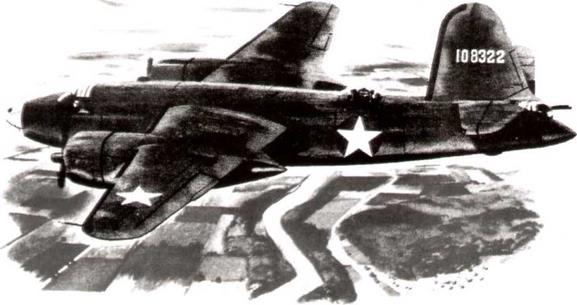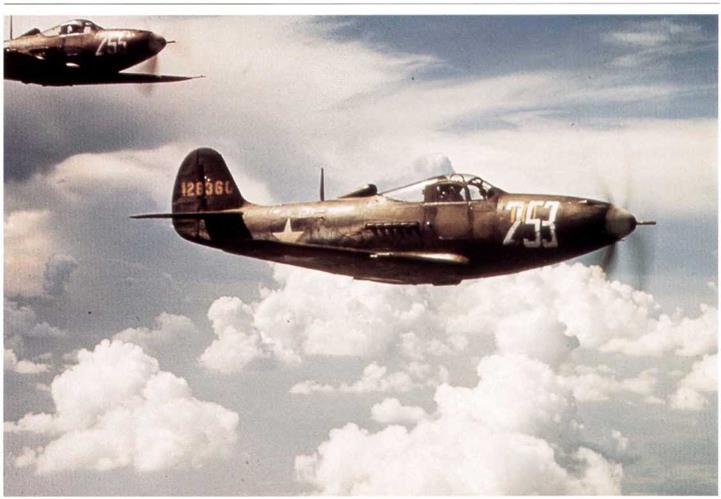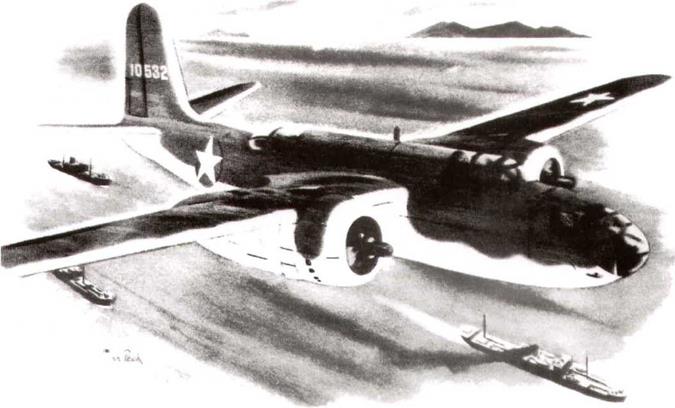CAMOUFLAGING OF AIRCRAFT
1. AIRCRAFT TO BE CAMOUFLAGED.
All United States Аллу Air Forces aircraft will be camouflaged in accordance with Army Air Forces Specification No. 24114, with the following exceptions:
a. Aircraft operating in the Alaskan Department or in any country having similar climatic and terrain conditions will not be basic camouflaged. However, either camouflage or marked contrast finishes may be used as specified in paragraph 2.a.(4)(d).
b. Training type of aircraft.
c. Aircraft of other types regularly used for training purposes by the Flying Training Command.
d. All types of aircraft not regularly assigned to, or normally located in, theaters of operation.
2. TYPES OF CAMOUFLAGE FINISHES.
a. PERMANENT CAMOUFLAGE.
(1) TYPES AND APPLICATIONS.—Paragraph E-lb of Army Air Forces Specification No. 24114, permits the use of lacquer and enamel materials on metal surfaces, dope on fabric, subject to the provisions herein. It will be noted that the use of both types of materials for metal require use of primer, zinc chromate. Camouflage materials in kind can be satisfactorily applied over existing protective coatings, that is, specification camouflage lacquer over existing lacquer finishes, specification camouflage enamel over existing enamel finishes, and specification camouflage dope over existing dope finishes. It is anticipated that there will be minor chipping of the camouflage materials at the leading edges of airfoils, which may be somewhat unsightly, but as long as the material affords a reasonable coverage of the surface, the finish will not be touched up. However, touching-up of permanently camouflaged surfaces is authorized, if the permanent camouflage has been partially destroyed by brushing action in removing temporary camouflage. No attempt will be made to secure a high gloss as this will tend to defeat the purpose of camouflage.
(2) PAINTS TO BE USED ON CAMOUFLAGED AIRPLANES.—The only permanent exterior paints that will be applied to camouflaged airplanes will be the following Air Forces camouflage materials in colors covered by Air Forces Bulletin No. 41:
(a) Lacquer, Specification No. 14105.
(b) Dope, Specification No. 14106.
(c) Enamel, Specification No. 14109.
These specifications are being revised to include infra-red reflectance qualities which decrease photographic qualities of a plane. This new paint will be used on all planes consigned to overseas theaters. Primer, zinc chromate, Specification No. AN-TT-P-656, will be used wherever a primer coat is required. Special de-icer paint is available only in oyster white for use on white camouflage.
NOTE
It will be borne in mind that essentially, all paints, dopes, and lacquers are of a toxic nature and inflammable. Therefore, precautionary measures will be exercised in handling and application (See T. 0. No. 07-1-4 and Army Air Forces Regulation No. 85-6.)
|
Basic Camouflage |
|
Bell P-39D-1-BE, 41-28361, aircraft “253”, close up view, shows off the dark olive drab camouflage finish. (USAF) |
|
Sea Search |
(3) BASIC CAMOUFLAGE.—The basic camouflage scheme in permanent camouflage materials for Army Air Forces aircraft is dark olive drab, shade No. 41, for surfaces viewed from above and extending down on sides of fuselage; medium green, shade No. 42, in irregular splotches along all edges on the upper side of the wing and the horizontal outline of the tail assembly; also, along all edges of both sides of the vertical outline of the tail assembly, extending inward from the edges for various distances up to 20 percent of the total width of the wing or the tail assembly. Rubber parts will not be painted except utilizing white de-icer paint in white camouflage. (See figure I.) Neutral gray, shade No. 43, will be used for surface viewed from below. Masking will not be employed to separate ANY COLORS. Junction lines will be blended by overspraying. (See figure 9.)
(4) SPECIAL.—Use of one coat of the following special permanent finishes over material of like type is authorized (also temporary Specification No. 14057), as required to conform to existing local terrain.
(a) Medium green, shade No. 42, on upper wing and fuselage surfaces for aircraft operating over terrain predominately green,
(b) Sand, shade No, 49, for upper surfaces for aircraft operating over desert terrain.
(c) Black, shade No. 44, for under surfaces for aircraft to be used for night flying.
(d) To provide marked contrast for spotting forced landings, or to provide camouflage, as required by the Commanding Officers, the use of any camouflage materials in color covered by Bulletin No. 41 may be used for aircraft in Alaskan or other theaters having similar terrain conditions.
(e) Insignia white, shade No, 46, on all under surfaces and leading edges and olive drab, shade No. 41, on all upper surfaces for aircraft assigned to seasearch duty. Special de-icer paint in oyster white is available only for this and similar camouflage outlined in preceding paragraph.
(5) CAMOUFLAGE OF PROPELLER. — The camouflage of propellers, as required by Army Air Forces Specification No. 24114, will be accomplished by spraying each propeller blade in a horizontal position and retaining the propeller in this position until the camouflaging materials have set, after which it will be necessary that the propeller be checked for balance. Over one light coat of zinc chromate primer, one coat of black lacquer, shade No. 44, will extend to within 4 inches of the tip of the blade; this 4-inch tip will be yellow lacquer, shade No. 48, one light coat. When necessary, three and four blade metal props may be lightly “touched-up” between overhaul periods while installed on the plane. Care should be taken to apply proportionate amounts of paint to each blade to maintain the proper balance.
After overhaul the propellers will be repainted as outlined above, and balanced. No attempt will be made to camouflage wood propellers,
b. TEMPORARY CAMOUFLAGE.—Paint, water dry, Army Air Forces Specification No. 14057, in the following shades may be applied over existing permanent camouflage finishes when required and directed by com manders in the theaters of operation.
(1) Sea green, shade No. 28, for upper surfaces when operating over terrain predominately green.
(2) Black, shade No.33, for the lower surfaces of night flying aircraft
(3) Sand, shade No. 26, for upper surfaces when operating over desert terrain.
SECTION II













